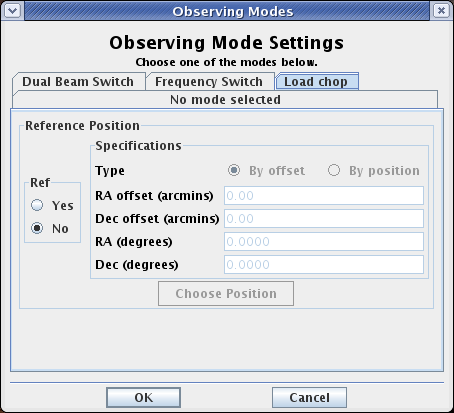The spectral scan AOT allows the user to setup HIFI so that multiple LO settings are observed over a wide frequency range (see Figure 13.26, “ HIFI spectral scan setup window”). In principle this allows complete coverage of a HIFI mixer band to be set up in a single observation, although a part of a band may also be chosen. The mode uses Dual Beam Switch (DBS) or Frequency Switch at a single position (single point DBS and frequency switch are discussed in Section 13.2.7.1, “Dual Beam Switch (DBS) mode” and Section 13.2.7.3, “Frequency Switch mode” respectively).
Only the WBS is used in this mode to provide the wide spectral bandpass.
For either mode, the user has the choice of either creating a spectral scan of the whole set of frequencies available in a given mixer band, or just over part of a band. The first pull-down menu allows selection of a particular mixer. The frequency range it covers is shown in the "Range from (GHz)" and "Range to (GHz)" windows.
The frequency range can be reduced by selecting "Partial" rather than "Full" from "Range" pull-down menu (the second one down). Selecting "Partial" allows editing of the "Range from (GHz)" and "Range to (GHz)" boxes so that the appropriate frequency range is covered.
Experiments suggest that scans of less than 20GHz in frequency range are NOT RECOMMENDED. It is recommended that the range of frequencies to be surveyed is larger than this.
Since HIFI is a dual sideband instrument, we need to separate out the contributions from two separate spectral ranges in our data. The tools for this are currently being developed (see the HIFI Observers' Manual (http://herschel.esac.esa.int/Docs/HIFI/html/hifi.html for more information). These tools involve a deconvolution of the spectral scan dataset to form a single sideband spectrum where the overlaying parts of the spectrum have been disentangled. In order for such a deconvolution to be accomplished then the 4GHz IF frequency range of HIFI needs to be sampled many times. A redundancy parameter is used to indicate the degree of oversampling of the frequency range. The default value is 4, meaning that 4 spectra are taken for every 4GHz (or 2.4GHz in bands 6 and 7), or approximately one spectrum for every 1GHz of spectrum to be surveyed.
A minimum redundancy of 4 is recommended. A redundancy of 2 is really only useful for cases where the spectrum is known to be sparse in terms of the density of lines.
It is possible to use HSpot to select whether the "best" or both polarizations of the WBS are to be used in the observation.
Since the DBS spectral scan mode uses (as its basis) the Dual Beam Switch capability of HIFI, it is also possible to choose a fast chop mode or a calibration timing suitable for continuum measurements (see Section 13.3.4.3, “Fast Chop and Continuum Timing” for details of these options).
To select these hit the "Select the observing mode" button in the Figure 13.26, “ HIFI spectral scan setup window” window and click on the "Dual Beam Switch" tab in the following window. This provides Figure 13.27, “ HIFI spectral scan with dual beam switch setup window” window.
As for other frequency switch modes of HIFI, the user has the choice of "small positive", "large positive", "small negative" or "large negative" frequency throws.
To select the frequency throw, click the "Select the observing mode" button in the Figure 13.26, “ HIFI spectral scan setup window” window and click on the "Frequency Switch" tab in the following window. This provides the Figure 13.28, “ HIFI spectral scan with frequency switch window” window.
An OFF position is also selectable in this window. A choice of offset or absolute positions can be made (see the section called “Identifying a reference position”.
Similarly to the On-the-Fly AOT, the spectral scan can also be performed with a Load Chop referencing scheme as alternative to the Frequency Switch scheme (see Section 13.3.3, “On-the-Fly Scanning Map with Load Chop”).
The mode does not require the user to use a reference OFF position but accurate bandpass measurements allowing for best continuum baseline removal should very likely use a load chop measurement of an OFF position too.
The time estimator for spectral scans works the same way as for the other HIFI modes (see Section 13.2.8, “Time Estimator Settings”). The only difference being that, since the WBS is being used for this mode, the "Goal Resolution Minimum" should be at least 1.1MHz.
Note that during observations it will take time to setup and accumulate data at multiple LO frequencies, so low input user times to the time estimator will lead to the time estimator returning a useable "minimum" time for the scan. For full scans covering a whole band the user can expect at least one hour (at a minimum redundancy of 2) for a minimum time estimate.
It should also be noted that unrealistically low noise goals will inevitably lead to time estimates that are much larger than the 18 hours allowed by the observatory.
![[Warning]](../../admonitions/warning.gif) | Warning |
|---|---|
| The HIFI time estimator can currently take some time to make a time estimate (occasionally more than one minute). This is particularly for the more complex modes such as spectral scans. |



